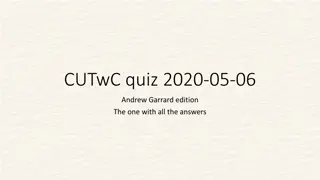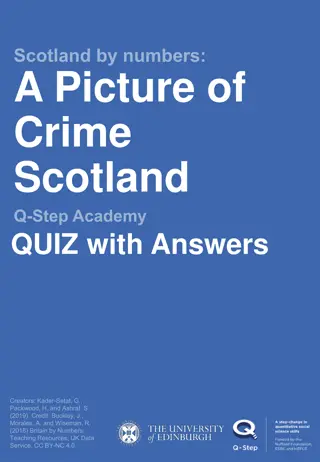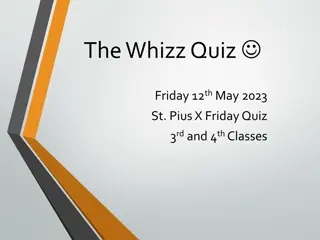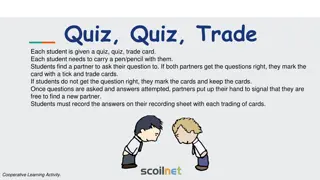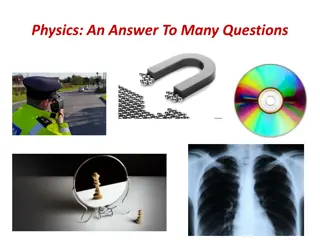Fun Physics Quiz Challenge for You!
Test your physics knowledge with this interactive quiz featuring questions on various topics like speed, distance, velocity, and more. Find out if you can answer them correctly and learn new concepts along the way. Enjoy the challenge and see how well you do!
Download Presentation

Please find below an Image/Link to download the presentation.
The content on the website is provided AS IS for your information and personal use only. It may not be sold, licensed, or shared on other websites without obtaining consent from the author.If you encounter any issues during the download, it is possible that the publisher has removed the file from their server.
You are allowed to download the files provided on this website for personal or commercial use, subject to the condition that they are used lawfully. All files are the property of their respective owners.
The content on the website is provided AS IS for your information and personal use only. It may not be sold, licensed, or shared on other websites without obtaining consent from the author.
E N D
Presentation Transcript
Do you have a clicker with you today? A)Yes! B)No, I do not have a clicker, so I cannot vote
Have you taken physics before? A) Took it and understood it well. B) Took it but did not understand it well. C) No, this is my first time!
A tennis racket and can of balls (together) costs $110. The tennis racket alone costs $100 more than the can of balls alone. How much does the can of balls alone cost? A) $5 B) $10 C) $11 D) $100 E) None of these
1 meter = 100 centimeters (1 m = 100 cm). How many square centimeters in one square meter? (How many cm2 in 1 m2?) A) 10 B) 100 C) 1000 D) 10,000 E) 100,000
Speed is defined as distance/time. If it takes 20 s for Jill to travel 1.0 km in her car, how fast is Jill travelling in m/s? A) 20 m/s B) 20,000 m/s C) 50 m/s D) 0.05 m/s
A person starts in Boulder, drives to Denver (50 km away) in 1 hour, stays in Denver for 1 hour, then speeds back to Boulder in 30 minutes. What is the average speed of this round trip? A) zero B) 67 km/hr C) 40 km/hr D) 75 km/hr E) none of these
A person starts in Boulder, drives to Denver (50 km away) in 1 hour, stays in Denver for 1 hour, then speeds back to Boulder in 30 minutes. What is the average velocity of this round trip? A) zero B) 67 km/hr C) 40 km/hr D) 75 km/hr E) none of these
You drive 4 miles at 30 mi/hr and then another 4 miles at 50 mi/hr. What is your average speed for the whole 8-mile trip? A) more than 40 mi/hr B) equal to 40 mi/hr C) less than 40 mi/hr
A person initially at point 3 on the x-axis stays there for a little while, then strolls along the x-axis to point 1, stays there for a moment and then runs to point 2 and remains there. Which of the following graphs correctly depicts this motion?
An object starts at ? = +5 and moves left along the x-axis at constant speed. Which graph represents this motion?
The position vs time of a train moving on a straight track is shown. Compare the average velocity, ?, between times 1 and 3 with the instantaneous velocity, ?2, at the instant in time labeled 2. A) ? = ?2 B) ? > ?2 C) ? < ?2
The strobe photograph" below shows a ball rolling along a surface. The camera flashed once a second, and the time is shown above each image. Which graph shows the ball s velocity vs. time? A B C D
Consider this velocity versus time graph. Which graph correctly shows acceleration vs. time? a a B A t t a a D C t t E Something entirely different!
A truck traveling 50 km/hr approaches a car stopped at a light. When the truck is 100 m behind the car (x0=0), the light turns green (t=0), and the car accelerates forward at 2 m/s2. Which graph depicts this situation? car x car x B A t t truck truck car x C D) None of these t truck
A train car moves along a long straight track. The graph shows the position as a function of times for the train. The graph shows that the train A) speeds up all the time. B) slows down all the time. C) speeds up part of the time and slows down part of the time. D) moves at constant velocity. E) None of these statements are true.
The graph shows velocity vs. time for a train moving along a straight track. The graph shows that the train is v t A) speeding up all the time. B) slowing down all the time. C) speeding up initially, but then slows down. D) slowing down initially, but then speeds up. E) changing direction.
A sprinters velocity increases, reaches a maximum, and then decreases according to the equation ? = ?? ??2, with ? = 20 time when the sprinter reaches maximum speed. ? ?2 and ? = 5 ? ?3. Find the A) 1 s B) 2 s C) 4 s D) none of these
An objects velocity vs. time is shown. Which graph best represents the objects acceleration vs. time?
In which of the following cases does a car have a negative velocity and a positive acceleration? A car that is traveling in the A) +x-direction increasing in speed B) -x-direction increasing in speed C) +x-direction decreasing in speed D) -x-direction at a constant 20 m/s E) -x-direction decreasing in speed
In which of the following cases does a car have a negative velocity and a negative acceleration? A car that is traveling in the A) +x-direction increasing in speed B) -x-direction increasing in speed C) +x-direction decreasing in speed D) -x-direction decreasing in speed E) -x-direction at a constant 20 m/s
A ball is thrown upward. At the moment the velocity is zero, what is the sign of the acceleration? A) Positive B) Negative C) Zero
The distance ? traveled by a ball in a time ? is given by the formula, ? =1 2??2, where ? is a non-zero positive constant. If the ball travels a distance ? in ? seconds, how far will it have traveled (total distance) in 3? seconds? A) 3? 9 2? B) C) 9? D) Impossible to know without values for ? and ?
The distance ? traveled by a ball in a time ? is given by the formula, ? =1 2??2, where ? is a non-zero positive constant. If the ball travels a distance ? in ? seconds, how far will it have traveled (total distance) in 3? seconds? A) 3? 9 2? B) C) 9? D) Impossible to know without values for ? and ?
A student is asked the following question: A car is moving to the right with a constant velocity of ? = +21 m/s. Suddenly the brakes are applied, and the car slows to a stop with constant acceleration in 3 seconds. What is the acceleration ?of the car? Which of the following formulas should the student use to answer the question? A) ? = ?0+ ?? B) ? = ?0+ ?0? +1 2??2 C) ?2= ?02+ 2? ? ?0 D) ? =?0+? 2
You drop a very bouncy rubber ball. It falls, and then it hits the floor and bounces right back up to you. Which of the following represents the v vs. t graph for this motion?
A rock is given an initial throw downward with speed ?0, falling a distance to the ground. Down is chosen as +?, and the origin is at ground level. What is ?0 (initial position) and ? (acceleration)? A) ?0= + , a = ? B) ?0= , a = +? C) ?0= 0, a = +? D) ?0= , a = ? E) ?0= 0, a = ?
A rock is given an initial throw downwards with speed ?0. This time UP is chosen as the positive direction. What is the correct formula for velocity as a function of time? A) ? = ?0+ ?? B) ? = ?0 ?? C) ? = ?0 ?? D) ? = ?0+ ?? E) None of these
A rock is thrown (initial speed is ?0) straight down at ? = 0. Ignore air resistance. It strikes the ground a distance below. A student is asked to compute the final speed of the rock, just before it hits the ground. Which formula should she use to find the answer most quickly? A) ? = ?0+ ?? B) ? = ?0+ ?0? +1 2??2 C) ?2= ?02+ 2? ? ?0 D) None of the above will work
The graph shows positions as a function of time for two trains running on parallel tracks. Which statement is true? A) At time ??, both trains have the same velocity. B) Both trains speed up all the time. C) Both trains have the same velocity at some time before ??. D) Both trains have the same acceleration at some time before ??. E) None of the above statements are true.
A ball is thrown straight up with an initial speed ?0. Assume no air resistance. To compute the time to reach the top (apex), which formula is the easiest and quickest to use? A) ? = ?0+ ?? B) ? = ?0+ ?0? +1 2??2 C) ?2= ?02+ 2? ? ?0 D) None of the above will work
In the previous question, if the initial speed ?0 is doubled, the maximum height of the ball A) doubles. B) increases by a factor of 4. C) Neither of these. D) Impossible to tell from the information given.
An objects velocity vs. time graph looks like this: v t Which situation produces this kind of motion? A) A rock is thrown straight up B) A rock is dropped from rest C) A rock is thrown straight down D) A book slides and comes to rest E) More than one of the above
A truck traveling 50 km/hr approaches a car stopped at a light. When the truck is 100 m behind the car (x0=0), the light turns green (t=0), and the car accelerates forward at 2 m/s2. Which graph depicts this situation? car x car x B A t t truck truck car x C D) None of these t truck
Two stones are dropped into a bottomless pit. Stone 2 is dropped 2 seconds after stone 1 (which is dropped at ? = 0). Assume no air resistance. The velocity of stone 1 is ?1= ? ?. Which is the correct formula for ?2 after stone 2 is dropped? A) ?2= ? ? B) ?2= ? (? 2 s) C) ?2= ? (? + 2 s) D) None of these
Two stones are dropped into a bottomless pit. Stone 2 is dropped 2 seconds after stone 1. Assume no air resistance. As both stones fall, the difference in their velocities A) Increases with time B) Decreases with time C) Stays constant as time goes by
Two stones are dropped into a bottomless pit. Stone 2 is dropped 2 seconds after stone 1. Assume no air resistance. As both stones fall, the difference in their y-positions A) Increases with time B) Decreases with time C) Stays constant as time goes by














